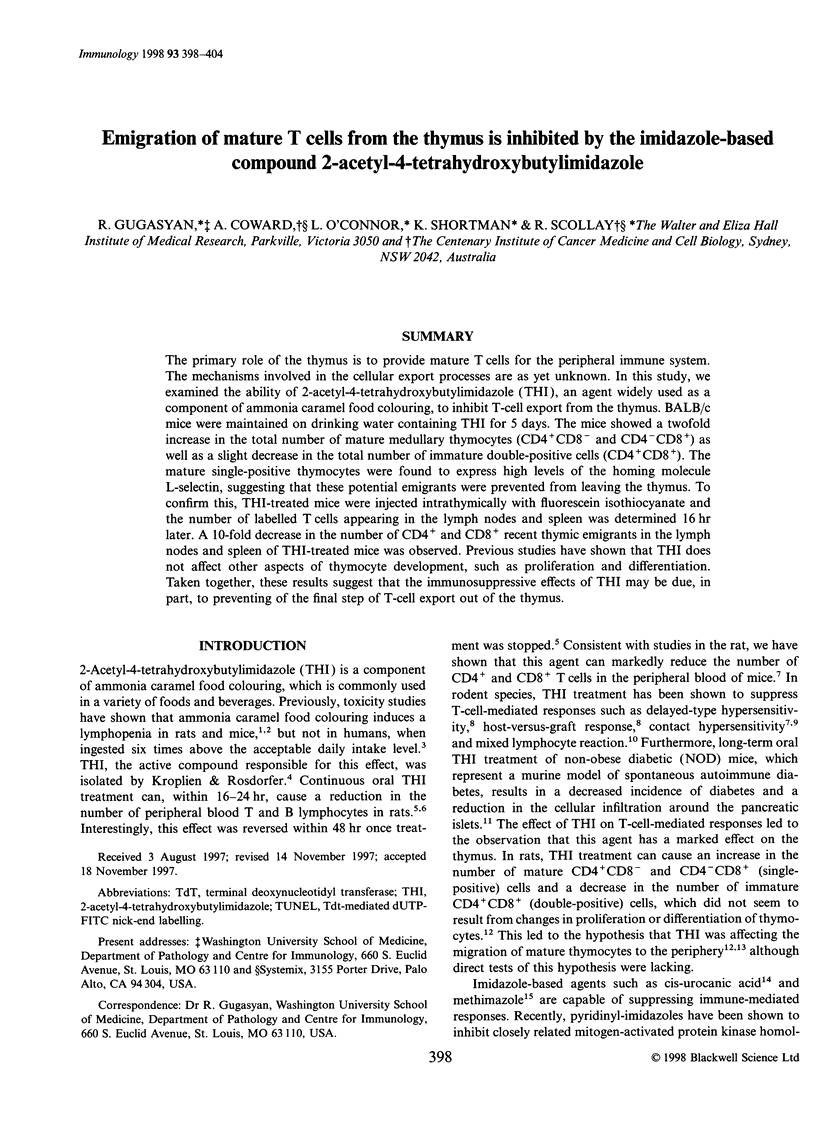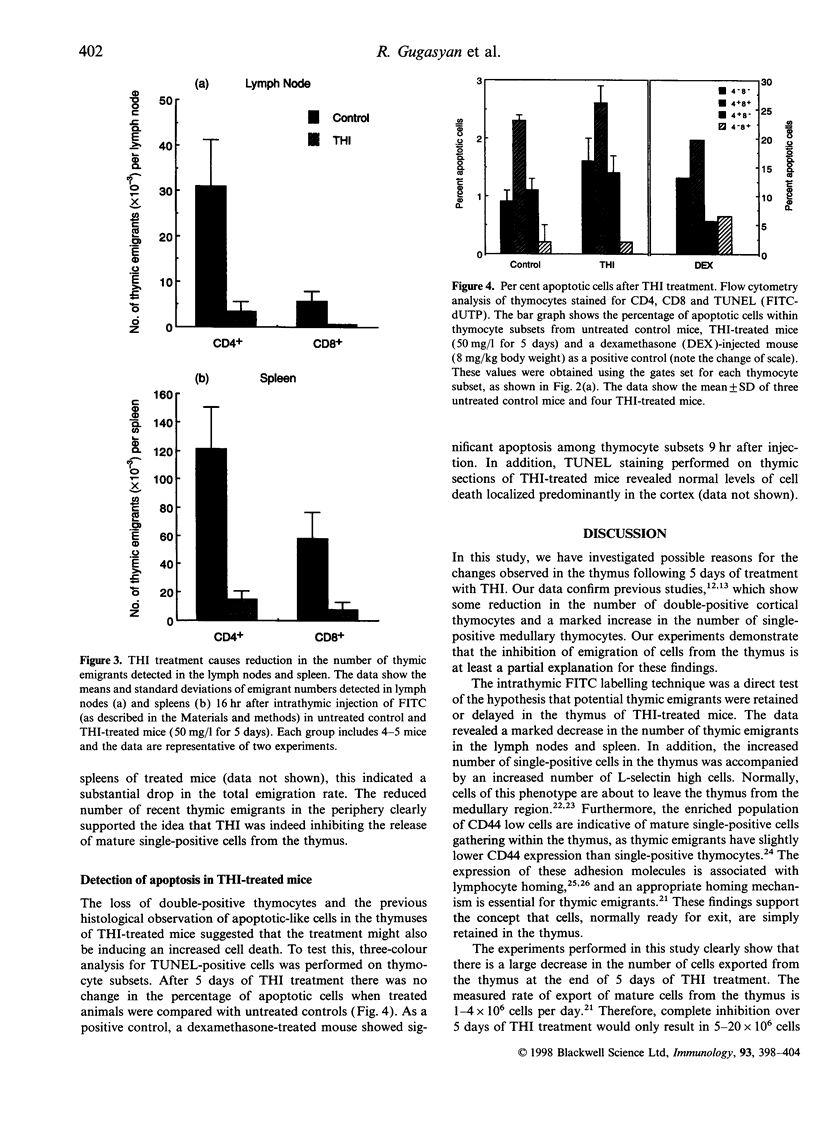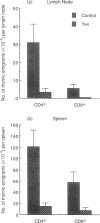Abstract
The primary role of the thymus is to provide mature T cells for the peripheral immune system. The mechanisms involved in the cellular export processes are as yet unknown. In this study, we examined the ability of 2-acetyl-4-tetrahydroxybutylimidazole (THI), an agent widely used as a component of ammonia caramel food colouring, to inhibit T-cell export from the thymus. BALB/c mice were maintained on drinking water containing THI for 5 days. The mice showed a twofold increase in the total number of mature medullary thymocytes (CD4+CD8- and CD4-CD8+) as well as a slight decrease in the total number of immature double-positive cells (CD4+CD8+). The mature single-positive thymocytes were found to express high levels of the homing molecule L-selectin, suggesting that these potential emigrants were prevented from leaving the thymus. To confirm this, THI-treated mice were injected intrathymically with fluorescein isothiocyanate and the number of labelled T cells appearing in the lymph nodes and spleen was determined 16 hr later. A 10-fold decrease in the number of CD4+ and CD8+ recent thymic emigrants in the lymph nodes and spleen of THI-treated mice was observed. Previous studies have shown that THI does not affect other aspects of thymocyte development, such as proliferation and differentiation. Taken together, these results suggest that the immunosuppressive effects of THI may be due, in part, to preventing of the final step of T-cell export out of the thymus.
Full text
PDF






Images in this article
Selected References
These references are in PubMed. This may not be the complete list of references from this article.
- Agus D. B., Surh C. D., Sprent J. Reentry of T cells to the adult thymus is restricted to activated T cells. J Exp Med. 1991 May 1;173(5):1039–1046. doi: 10.1084/jem.173.5.1039. [DOI] [PMC free article] [PubMed] [Google Scholar]
- Bradbury M. G., Doherty K. V., Parish C. R., Lyons A. B. The immunosuppressive compound 2-acetyl-4-tetrahydroxybutyl imidazole inhibits the allogeneic mixed lymphocyte reaction by sequestration of a recirculating subpopulation of T cells. Immunology. 1996 Jan;87(1):80–85. [PMC free article] [PubMed] [Google Scholar]
- Evans J. G., Butterworth K. R., Gaunt I. F., Grasso P. Long-term toxicity study in the rat on a caramel produced by the 'half open-half closed pan' ammonia process. Food Cosmet Toxicol. 1977 Dec;15(6):523–531. doi: 10.1016/0015-6264(77)90066-9. [DOI] [PubMed] [Google Scholar]
- Gallatin W. M., Weissman I. L., Butcher E. C. A cell-surface molecule involved in organ-specific homing of lymphocytes. Nature. 1983 Jul 7;304(5921):30–34. doi: 10.1038/304030a0. [DOI] [PubMed] [Google Scholar]
- Gaunt I. F., Lloyd A. G., Grasso P., Gangolli S. D., Butterworth K. R. Short-term study in the rat on two caramels produced by variations of the "ammonia process". Food Cosmet Toxicol. 1977 Dec;15(6):509–521. doi: 10.1016/0015-6264(77)90065-7. [DOI] [PubMed] [Google Scholar]
- Gobin S. J., Legg R. F., Paine A. J., Phillips J. A. The effect of 2-acetyl-4-tetrahydroxybutylimidazole on lymphocyte subsets in peripheral blood of the rat. Int J Immunopharmacol. 1989;11(8):937–946. doi: 10.1016/0192-0561(89)90116-1. [DOI] [PubMed] [Google Scholar]
- Gobin S. J., Legg R. F., Paine A. J. The role of lymphocyte production and migration in the lymphopenia caused by 2-acetyl-4-tetrahydroxybutyl imidazole. Int J Immunopharmacol. 1992 May;14(4):687–697. doi: 10.1016/0192-0561(92)90132-5. [DOI] [PubMed] [Google Scholar]
- Gobin S. J., Paine A. J. Effects of 2-acetyl-4-tetrahydroxybutyl imidazole (THI) on the thymus of rats. Thymus. 1992 Aug;20(1):17–30. [PubMed] [Google Scholar]
- Gobin S. J., Phillips J. A. Immunosuppressive effects of 2-acetyl-4-tetrahydroxybutyl imidazole (THI) in the rat. Clin Exp Immunol. 1991 Aug;85(2):335–340. doi: 10.1111/j.1365-2249.1991.tb05729.x. [DOI] [PMC free article] [PubMed] [Google Scholar]
- Gugasyan R., Losinno C., Mandel T. The effect of 2-acetyl-4-tetrahydroxybutylimidazole on lymphocyte subsets during a contact hypersensitivity response in the NOD mouse. Immunol Lett. 1995 Jun;46(3):221–227. doi: 10.1016/0165-2478(95)00048-a. [DOI] [PubMed] [Google Scholar]
- Houben G. F., Penninks A. H. Immunotoxicity of the colour additive caramel colour III; a review on complicated issues in the safety evaluation of a food additive. Toxicology. 1994 Aug 12;91(3):289–302. doi: 10.1016/0300-483x(94)90016-7. [DOI] [PubMed] [Google Scholar]
- Iscaro A., Mackay I. R., O'Brien C. Lymphopenic effects on mice of a component of ammonia caramel, 2-acetyl-4(5)-tetrahydroxybutylimidazole (THI). Immunol Cell Biol. 1988 Oct-Dec;66(Pt 5-6):395–402. doi: 10.1038/icb.1988.51. [DOI] [PubMed] [Google Scholar]
- Kelly K. A., Scollay R. Analysis of recent thymic emigrants with subset- and maturity-related markers. Int Immunol. 1990;2(5):419–425. doi: 10.1093/intimm/2.5.419. [DOI] [PubMed] [Google Scholar]
- Lee J. C., Laydon J. T., McDonnell P. C., Gallagher T. F., Kumar S., Green D., McNulty D., Blumenthal M. J., Heys J. R., Landvatter S. W. A protein kinase involved in the regulation of inflammatory cytokine biosynthesis. Nature. 1994 Dec 22;372(6508):739–746. doi: 10.1038/372739a0. [DOI] [PubMed] [Google Scholar]
- Lesley J., Hyman R., Kincade P. W. CD44 and its interaction with extracellular matrix. Adv Immunol. 1993;54:271–335. doi: 10.1016/s0065-2776(08)60537-4. [DOI] [PubMed] [Google Scholar]
- Mandel T. E., Koulmanda M., Mackay I. R. Prevention of spontaneous and cyclophosphamide-induced diabetes in non-obese diabetic (NOD) mice with oral 2-acetyl-4-tetrahydroxybutylimidazole (THI), a component of caramel colouring III. Clin Exp Immunol. 1992 Jun;88(3):414–419. doi: 10.1111/j.1365-2249.1992.tb06464.x. [DOI] [PMC free article] [PubMed] [Google Scholar]
- Noonan F. P., De Fabo E. C. Immunosuppression by ultraviolet B radiation: initiation by urocanic acid. Immunol Today. 1992 Jul;13(7):250–254. doi: 10.1016/0167-5699(92)90005-R. [DOI] [PubMed] [Google Scholar]
- Phillips J. A., Paine A. J. Effect of pyridoxine on the disposition and lymphopenic effects of 2-acetyl-4(5)-tetrahydroxybutyl imidazole in the rat. Xenobiotica. 1990 Jun;20(6):555–562. doi: 10.3109/00498259009046870. [DOI] [PubMed] [Google Scholar]
- Reeve V. E., Boehm-Wilcox C., Bosnic M., Rozinova E. Suppressive effect of 2-acetyl-4-tetrahydroxybutylimidazole on contact hypersensitivity in the Skh: HR hairless mouse. Int Arch Allergy Immunol. 1993;102(1):101–106. doi: 10.1159/000236557. [DOI] [PubMed] [Google Scholar]
- Reichert R. A., Gallatin W. M., Butcher E. C., Weissman I. L. A homing receptor-bearing cortical thymocyte subset: implications for thymus cell migration and the nature of cortisone-resistant thymocytes. Cell. 1984 Aug;38(1):89–99. doi: 10.1016/0092-8674(84)90529-4. [DOI] [PubMed] [Google Scholar]
- Reichert R. A., Weissman I. L., Butcher E. C. Phenotypic analysis of thymocytes that express homing receptors for peripheral lymph nodes. J Immunol. 1986 May 15;136(10):3521–3528. [PubMed] [Google Scholar]
- Scollay R. G., Butcher E. C., Weissman I. L. Thymus cell migration. Quantitative aspects of cellular traffic from the thymus to the periphery in mice. Eur J Immunol. 1980 Mar;10(3):210–218. doi: 10.1002/eji.1830100310. [DOI] [PubMed] [Google Scholar]
- Sgonc R., Boeck G., Dietrich H., Gruber J., Recheis H., Wick G. Simultaneous determination of cell surface antigens and apoptosis. Trends Genet. 1994 Feb;10(2):41–42. doi: 10.1016/0168-9525(94)90140-6. [DOI] [PubMed] [Google Scholar]
- Shortman K., Wilson A., Van Ewijk W., Scollay R. Phenotype and localization of thymocytes expressing the homing receptor-associated antigen MEL-14: arguments for the view that most mature thymocytes are located in the medulla. J Immunol. 1987 Jan 15;138(2):342–351. [PubMed] [Google Scholar]
- Singer D. S., Kohn L. D., Zinger H., Mozes E. Methimazole prevents induction of experimental systemic lupus erythematosus in mice. J Immunol. 1994 Jul 15;153(2):873–880. [PubMed] [Google Scholar]
- Sinkeldam E. J., de Groot A. P., van den Berg H., Chappel C. I. The effect of pyridoxine on the number of lymphocytes in the blood of rats fed caramel colour (III). Food Chem Toxicol. 1988 Mar;26(3):195–203. doi: 10.1016/0278-6915(88)90119-6. [DOI] [PubMed] [Google Scholar]
- Surh C. D., Sprent J. T-cell apoptosis detected in situ during positive and negative selection in the thymus. Nature. 1994 Nov 3;372(6501):100–103. doi: 10.1038/372100a0. [DOI] [PubMed] [Google Scholar]




